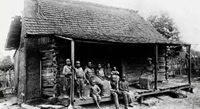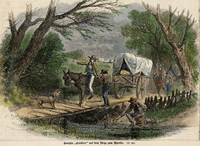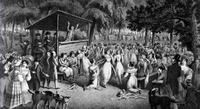In the antebellum period the majority of the population of this area were either yeomen or slaves. There were very few plantation owners or craftsmen. The lives of yeoman farmers and slaves were somewhat similar.
 Their homes were usually one or two-room cabins; their lives revolved around working in the fields; and their children became laborers at an early age. Their diet consisted mainly of salt pork, corn, sweet and white potatoes, and cornbread. The yeoman farmer, his wife, and children generally lived on a small farm of less than 100 acres. Some of the land was set aside for growing cotton. The rest of the land was used to grow crops for home consumption, like corn for bread. Farmers raised livestock for meat and milk. They supplemented their meat diet through hunting and fishing. They normally clothed themselves with cloth they wove and stitched together with thread they spun. Slaves were normally clothed in osnaburgs, “Negro cloth,” a cheap and durable fabric.
Their homes were usually one or two-room cabins; their lives revolved around working in the fields; and their children became laborers at an early age. Their diet consisted mainly of salt pork, corn, sweet and white potatoes, and cornbread. The yeoman farmer, his wife, and children generally lived on a small farm of less than 100 acres. Some of the land was set aside for growing cotton. The rest of the land was used to grow crops for home consumption, like corn for bread. Farmers raised livestock for meat and milk. They supplemented their meat diet through hunting and fishing. They normally clothed themselves with cloth they wove and stitched together with thread they spun. Slaves were normally clothed in osnaburgs, “Negro cloth,” a cheap and durable fabric.
 If yeoman farmers owned slaves, they often worked together in the fields and retired in the evening to sparsely furnished cabins. On plantations, slaves who worked in the fields were directed by overseers, often slaves themselves, and usually had little contact with the master. Slaves were able to grow a small amount of crops in their own gardens for personal consumption. This was an important addition to the meager diet they received from the slave owners.
If yeoman farmers owned slaves, they often worked together in the fields and retired in the evening to sparsely furnished cabins. On plantations, slaves who worked in the fields were directed by overseers, often slaves themselves, and usually had little contact with the master. Slaves were able to grow a small amount of crops in their own gardens for personal consumption. This was an important addition to the meager diet they received from the slave owners.
 Folk etymology claims the term cracker originated from piney-woods Georgia and Florida pastoral yeomen’s use of whips to drive cattle, as in “crack of the whip.” The word then came to be associated with the cowboys of Georgia and Florida.
Folk etymology claims the term cracker originated from piney-woods Georgia and Florida pastoral yeomen’s use of whips to drive cattle, as in “crack of the whip.” The word then came to be associated with the cowboys of Georgia and Florida.
 Religion represented a major diversion for both classes. The local church was usually the main form of community for the yeomanry. The yeomanry also enjoyed corn shucking, militia musters, marksmanship contests, hunting, and rough entertainment like gander pullings. They also enjoyed telling and listening to tall tales. Georgia, and particularly this area, has become associated with the tales of animals who played tricks on their enemies.
Religion represented a major diversion for both classes. The local church was usually the main form of community for the yeomanry. The yeomanry also enjoyed corn shucking, militia musters, marksmanship contests, hunting, and rough entertainment like gander pullings. They also enjoyed telling and listening to tall tales. Georgia, and particularly this area, has become associated with the tales of animals who played tricks on their enemies.
